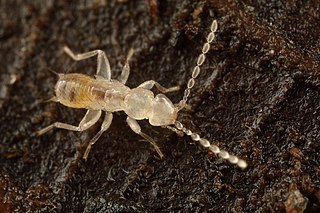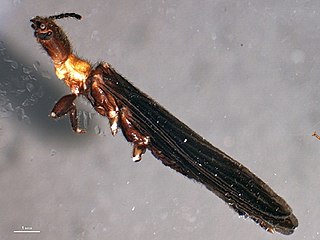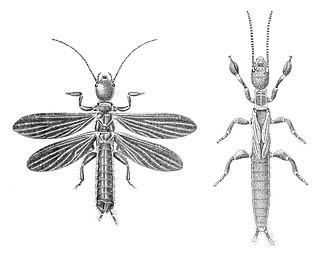
The insect order Zoraptera, commonly known as angel insects, contains small and soft bodied insects with two forms: winged with wings sheddable as in termites, dark and with eyes (compound) and ocelli (simple); or wingless, pale and without eyes or ocelli. They have a characteristic nine-segmented beaded (moniliform) antenna. They have mouthparts adapted for chewing and are mostly found under bark, in dry wood or in leaf litter.

The order Embioptera, commonly known as webspinners or footspinners, are a small group of mostly tropical and subtropical insects, classified under the subclass Pterygota. The order has also been called Embiodea or Embiidina. More than 400 species in 11 families have been described, the oldest known fossils of the group being from the mid-Jurassic. Species are very similar in appearance, having long, flexible bodies, short legs, and only males having wings.

The Stephanidae, sometimes called crown wasps, are a family of parasitoid wasps. They are the only living members of the superfamily Stephanoidea. Stephanidae has at least 345 living species in 11 genera. The family is considered cosmopolitan in distribution, with the highest species concentrations in subtropical and moderate climate zones. Stephanidae also contain four extinct genera described from both compression fossils and inclusions in amber.
Anisembiidae is a family of insects in the order Embioptera, the web-spinners. The family is divided into several subfamilies. It is the largest family of webspinners.

Sphaeropsocidae is a family of Psocodea, belonging to the suborder Troctomorpha. Females of this family have reduced, beetle-like elytra, and lack hindwings, with males have either small or absent wings. The family comprises 22 known species in eight genera.

The Berothidae are a family of winged insects of the order Neuroptera. They are known commonly as the beaded lacewings. The family was first named by Anton Handlirsch in 1906. The family consists of 24 genera and 110 living species distributed discontinuously worldwide, mostly in tropical and subtropical regions. Numerous extinct species have also been described. Their ecology is poorly known, but in the species where larval stages have been documented, the larvae are predators of termites.

Alderflies are megalopteran insects of the family Sialidae. They are closely related to the dobsonflies and fishflies as well as to the prehistoric Euchauliodidae. All living alderflies – about 66 species all together – are part of the subfamily Sialinae, which contains nine extant genera.
Edward Shearman Ross was an American entomologist. He majored in entomology at the University of California, Berkeley. Before his PhD was conferred, he worked as curator of insects at the California Academy of Sciences. He wrote many scientific and popular articles about the biology of the insects.

Haploembia solieri or bicolored webspinner is a species of webspinner in the family Oligotomidae. It is found in Europe, Northern Asia, and North America. Unlike Haploembia tarsalis, which reproduces asexually, H. solieri reproduces sexually. Adult specimens of H. solieri are orange and black and around 11 mm long.

Haploembia is a genus of webspinners in the family Oligotomidae. There are at least three described species in Haploembia. They are native to the Mediterranean, but have been observed in the western United States, and are adventive elsewhere.

Oligotomidae is a family of webspinners in the order Embioptera. There are about 6 genera and at least 40 described species in Oligotomidae.
Diradius is a genus of webspinners in the family Teratembiidae. There are about 15 described species in Diradius.

Dicromantispa is a genus of mantidflies in the family Mantispidae. There are about 10 described species in Dicromantispa.
Andesembiidae is a family of webspinners--insects of the order Embioptera. There are at least two genera and about seven described species in Andesembiidae.
Archembiidae is a family of webspinners in the order Embioptera. There are at least 2 genera and about 12 described species in Archembiidae.

Australembiidae is a family of webspinners in the order Embioptera. There is at least one genus, Metoligotoma, in the family Australembiidae.

Clothodidae is a family of webspinners in the order Embioptera. There are about 8 genera and 25 described species in Clothodidae.

Embiidae is a family of webspinners in the order Embioptera. There are more than 20 genera and 80 described species in Embiidae.
Paedembiidae is a family of webspinners in the order Embioptera. There are at least three genera and three described species in Paedembiidae.










